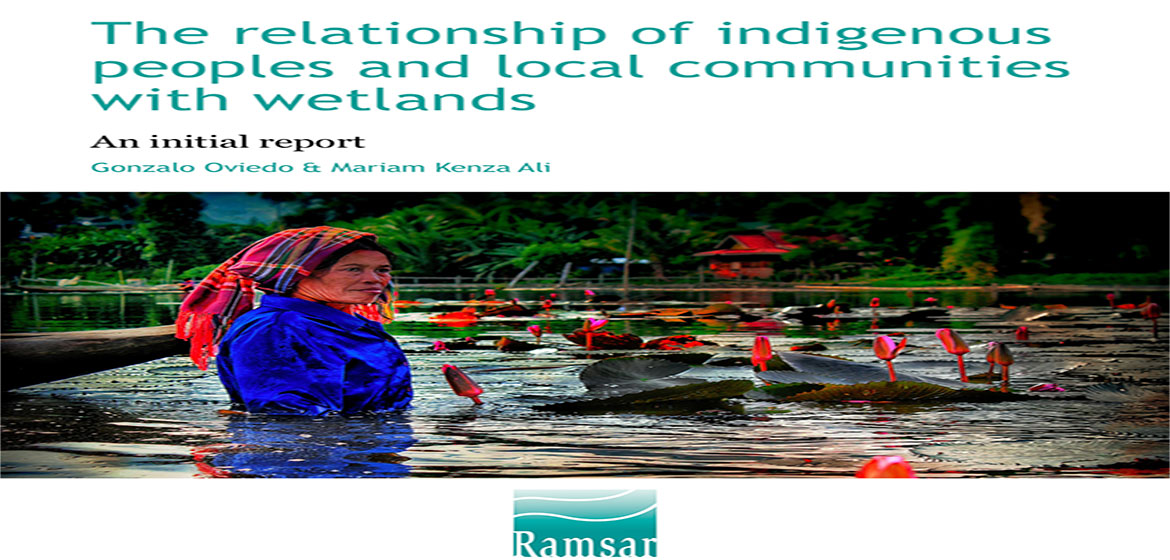The Ramsar Convention on Wetlands has a long-standing commitment to promote, recognize and strengthen the active participation of indigenous peoples, and local communities as key stakeholders for conservation and integrated wetland management (, para 19). In celebration of the ‘International Day for the World’s Indigenous Peoples’, which takes place on August 9th each year, the Ramsar Convention Secretariat has published an initial report on ‘The relationship of indigenous peoples and local communities with wetlands.’ This publication provides a compilation of the Convention’s available data on indigenous peoples and local communities, as requested by the Ramsar Conference of the Parties (Resolution XII.2, para 20).
The report also presents an overview of the Convention’s current policy framework, and provides examples of approaches from other relevant environmental policy processes, international law and practices that the Contracting Parties could consider in order to strengthen the Convention’s inclusive and participatory approach to wetland conservation and wise use.
Today, there are an estimated 370 million indigenous peoples across the world. Although they represent a relatively small portion of the global population, they account for the largest portion of linguistic and cultural diversity on Earth. The lands and waters traditionally occupied or used by indigenous peoples are also estimated to contain the majority of the world’s remaining biodiversity.
As the wetlands protected under the Ramsar Convention cover an area larger than Mexico (over 245,614,112 ha), Ramsar Sites overlap with the territories and lands of numerous indigenous peoples and local communities. Their wise and customary use of wetlands can therefore play and important role in the conservation of these ecosystems.
For example, the world’s very first Ramsar Site, the Cobourg Peninsula in Australia, has maintained its unique values and ecological character for nearly half a century through joint management by the traditional owners (the Arrarrkbi) and the Northern Territory Government (through the Parks and Wildlife Commission).
The data compiled from National Reports (150 COP12 reports) and the Ramsar Sites Information System (2,289 Ramsar Information Sheets) reveal the significant interest that Contracting Parties have in the active involvement of all stakeholders, including indigenous peoples and local communities, in wetland conservation and wise use.
For example, more than 70% of Contracting Parties promote the participation of stakeholders in decision-making on wetland planning and management, more than 50% involve local stakeholders in the selection of new Ramsar Sites, and over 90% of Ramsar Sites are recognized as providing cultural ecosystem services. However, less than 15% of Ramsar Sites are currently formally recognized under the Convention’s four ‘cultural characteristics’, which include wise use, cultural traditions, indigenous peoples and local communities, and non-material values such as sacred sites ().
A series of ‘options for action’ to strengthen participation and governance and enhance livelihood benefits are also suggested within the report. This includes updating the Convention’s 1999 ‘Guidelines for establishing and strengthening local communities’ and indigenous people’s participation in the management of wetlands’, in line with the 2007 UN Declaration on the Rights of Indigenous Peoples.
The upcoming thirteenth Conference of the Parties, which will take place in Dubai from 21-29 October 2018, will include discussions on strengthening the active participation of indigenous peoples, and local communities as key stakeholders for conservation and integrated wetland management in the context of a draft resolution on ‘Cultural values, indigenous peoples and local communities, and climate change mitigation and adaptation in wetlands.’
Source:
Related to SDG 13: Climate action and SDG 15: Life on land and SDG 14: Life below water



